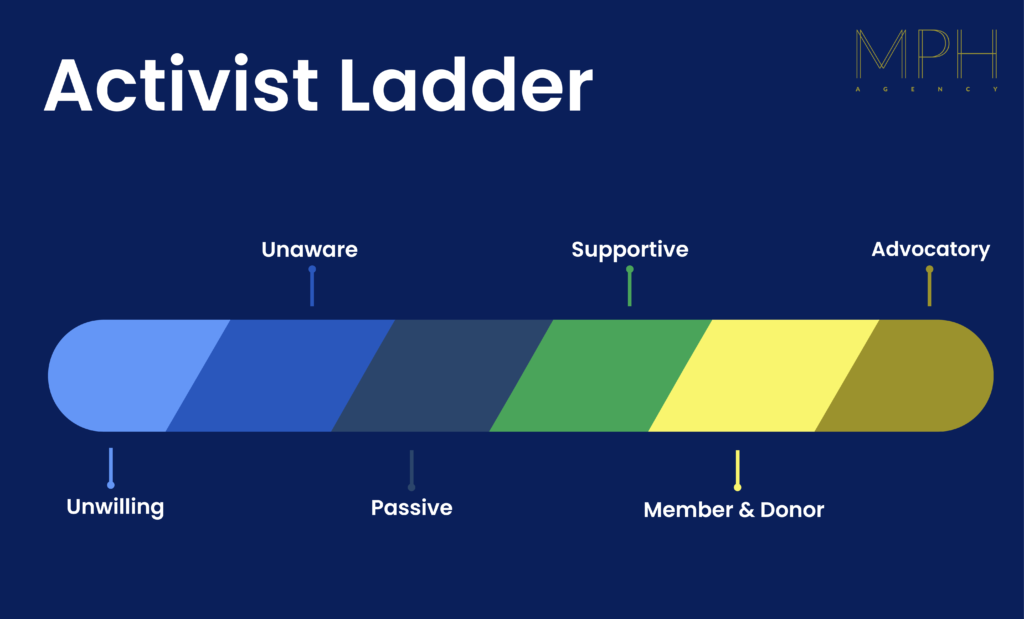The Activist Ladder
MPH Agency’s all-purpose tool for cause marketing
MPH Agency is proud to be one of Canada’s leading cause marketing agencies. Our work has always surrounded the grinding task of moving audiences. Whether it is mobilization, awareness, engagement, or fundraising, we lead with the most effective and best tested marketing methods and tools. We have released over 17,000 products for our clients since our founding (all the way back to when we were called MPrinthouse!), this means we have a library of tools available that are battle tested.
How we decide which tool to use, on which project, almost always starts with the same step. That is where MPH Agency’s Activist Ladder comes in.
We start the project by determining where on the Ladder our client's audience is, and determine where our client needs them to be. The steps in between define the challenge we have to undertake. Those steps in between also inform the tools we need to use to move the audience. Whether it's from passive to supportive, or all the way from unaware to advocatory we help our clients build the most effective marketing campaign, designed for the highest success rates.

Regardless of where an audience starts on the Activist Ladder (unaware, passive, supportive, or even unwilling) they will have to move through every one of the steps on the way to advocatory. There are no skipping steps, there is no shortcut, there is no ‘quick-fix’.
Moving audiences along the ladder is a deliberate and methodical, yet often occurs under very short timelines such as 36 days (IYKYK). Each step requires slight modifications to methods and messaging - this will better move your audience up the ladder. This is what we do, this is how we love to help our clients bring their audience along.
Each project, even in small or ad-hoc projects, our team applies the Activist Ladder. For larger programs, the Activist Ladder is one of the first steps in our trademarked STAMPS by MPH Agency product, where we work with clients from preliminary concept right through to execution. While we always prefer to work with our clients from the beginning with a STAMPS Strategy, sometimes the project or timeline does not allow for STAMPS’ in-depth planning process.
The Activist Ladder is made up of six different steps:
Unaware - This audience, simply put, has no idea that either you or your issue exist. They are living their life completely unaware of the current challenges you are facing, or that you need their help to solve your dilemma. Very often, MPH Agency is asked to help raise awareness for our clients or their issues. This is the process of moving select audiences from unaware to passive.
Passive - This audience knows about you and probably knows about your issue, but honestly…they just could not be bothered to get involved. Very often your issue may be in the news and gaining publicity but getting traction with your audiences and encouraging them to come help is the challenge. MPH Agency helps our clients persuade those passive audiences to become supportive.
Supportive - This audience knows about you, and your problems. They even are supportive of your goals and want to see your problems be solved. This is the first place public opinion research starts to identify people as for or against your issue. The reality is our clients need more! MPH Agency helps our clients move supporters to become members or donors.
Member & Donor - Members and donors not only know about your challenges, but are willing to invest! They want to see you succeed, and are willing to put their money behind it. They may even be willing to identify as a member of your organization (formally or informally) and associate with you on a long term, ongoing basis. But as Gordon Ramsay said on Hell’s Kitchen “Not Good Enough”. Money and membership is good, but having an advocate is always better! This is where MPH Agency uses highly specialized tools to bring your audience to the last step of the Activist Ladder
Advocatory - The ultimate level of engagement! This audience knows you, likes you, supports you, is invested in you, and is willing to give their name and time to help succeed! There is nothing more valuable to a cause movement than its advocates. Cherish them, appreciate them, and acknowledge their hard work! The work does not stop when you have an advocatory audience. You need to continually provide them with the motivation and appreciation to continue their work! MPH Agency runs on-going appreciation, and message campaigns to keep our clients advocates at the forefront of the cause market.
Unwilling - This audience knows exactly who you are and what you want. And they have no interest in helping you, seeing you succeed, and would probably be happy if they never heard from you again! That’s ok, you can’t please everyone! MPH Agency works diligently to make sure when unwilling are identified, contact and communication ends. No just to save you the budget space that can be better spent on other audiences or comply with DNC rules, but to ensure the unwilling are not further engaged!
In reality, the individuals that make up the audiences along the Activist Ladder are always moving up and down, from one step to another. This is why a strong cause marketing campaign is designed to work to keep people always moving to the next step and re-engaging those who are moving down.
If you’d like to see how the Activist Ladder applies to your cause marketing program, reach out to us! Our team at MPH Agency is excited to work with its clients to identify target audiences, place them on the Activist Ladder and devise tactics and plans to move people one step at a time to your cause objective.
Chris M. Rougier is Managing Partner at MPH Agency